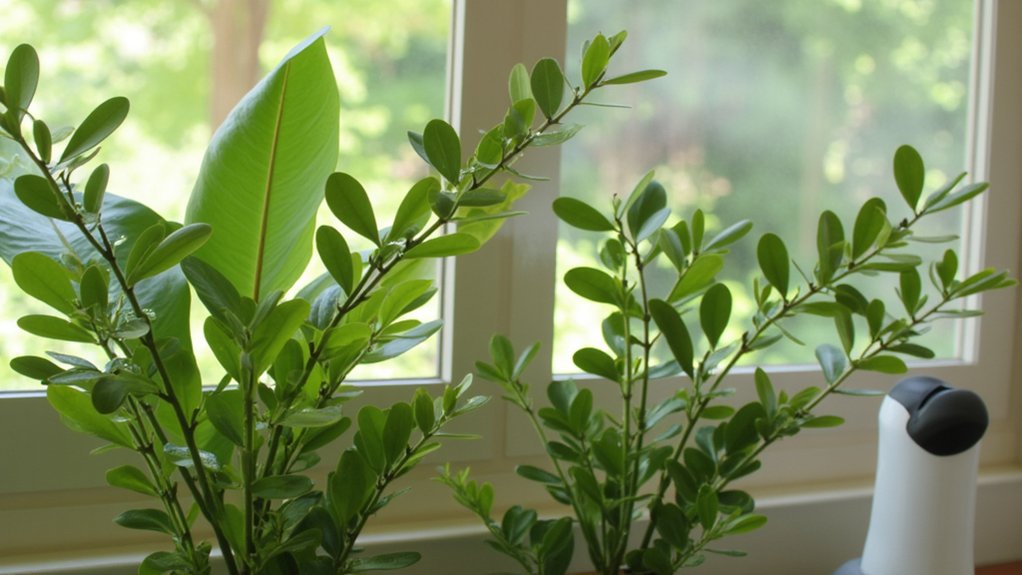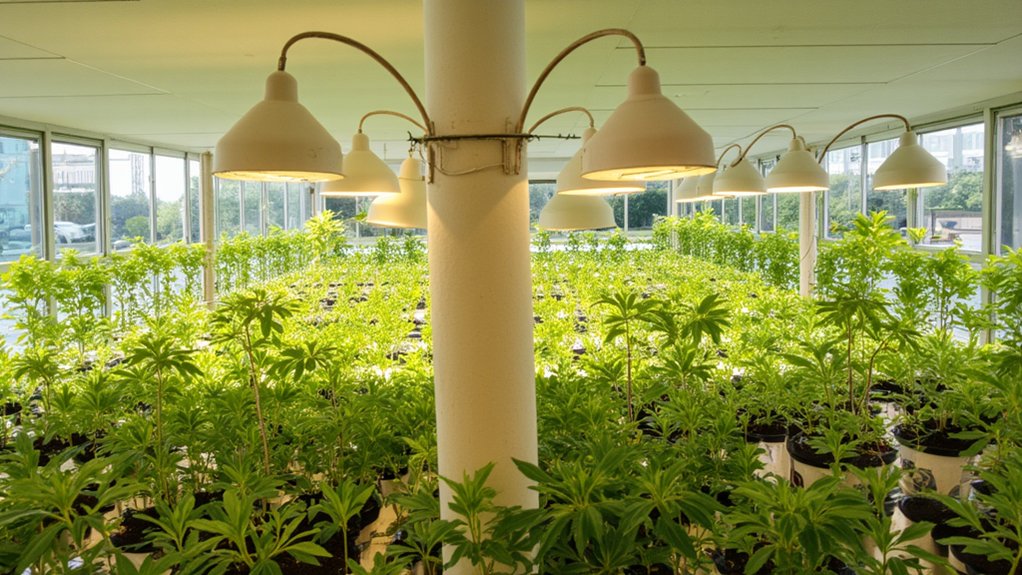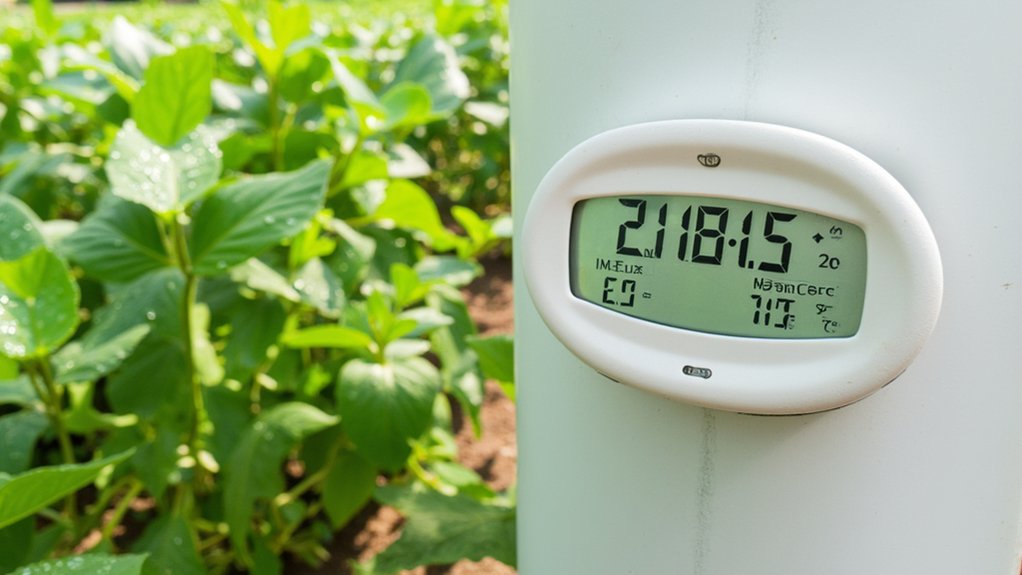Just as a conductor orchestrates each section of musicians to create perfect harmony, you’ll need to carefully coordinate multiple environmental factors to design your indoor garden’s microclimate. You’re about to discover how managing humidity levels, light exposure, and temperature can transform any indoor space into a thriving plant paradise. Whether you’ve got a sunny windowsill or a dark corner to work with, mastering these essential elements will help your plants flourish in ways you never thought possible.
Contents
- 1 Understanding Plant Humidity Needs and Control Methods
- 2 Optimizing Natural and Artificial Light Sources
- 3 Temperature Management for Healthy Plant Growth
- 4 Essential Air Circulation Techniques
- 5 Selecting and Grouping Plants by Environmental Requirements
- 6 Tools and Equipment for Microclimate Monitoring
- 7 Seasonal Adjustments for Year-Round Plant Success
Understanding Plant Humidity Needs and Control Methods

Although different plant species have evolved to thrive in varying moisture conditions, most indoor plants require humidity levels between 40-60% for ideal growth. You’ll need to monitor these levels with a hygrometer, which you can place near your plants for accurate readings.
To increase humidity, you’ve got several effective options. Try grouping plants together to create a moisture-sharing microclimate, or place containers on pebble-filled trays with water. For precise control, use a small humidifier with adjustable settings, positioning it 2-3 feet from your plants to prevent excess moisture on leaves.
When humidity’s too high, improve air circulation with a small fan and avoid overwatering.
Optimizing Natural and Artificial Light Sources

Beyond maintaining proper humidity levels, your indoor garden’s success depends heavily on proper lighting conditions. You’ll need to provide 12-16 hours of light daily, whether from natural sunlight, artificial grow lights, or a combination of both.
Position plants within 3 feet of south-facing windows to maximize natural light exposure. For artificial lighting, LED grow lights should hang 12-24 inches above your plants, adjusting height based on the specific growth stage and plant type.
Don’t forget to rotate your plants weekly, and clean light fixtures monthly. During winter months, you’ll likely need supplemental lighting even for plants near windows.
Temperature Management for Healthy Plant Growth

When creating the perfect indoor growing environment, maintaining consistent temperatures becomes your next critical focus. Most indoor plants thrive between 65-75°F during the day and prefer a slight drop of 5-10°F at night.
You’ll need to monitor your space with a reliable thermometer, placing it at plant level rather than higher up where warm air collects. Watch for cold drafts from windows or AC vents, which can shock your plants. If temperatures fluctuate too much, consider using a space heater with a thermostat or installing thermal curtains.
During summer months, use oscillating fans to circulate air and prevent heat pockets from forming around your plants.
Essential Air Circulation Techniques
Since stagnant air creates the perfect environment for plant diseases and pests, proper air circulation becomes a foundational element of any successful indoor garden. You’ll need to position fans strategically, ensuring they’re at least 2-3 feet away from your plants while maintaining gentle, continuous airflow.
Install an oscillating fan at plant height, and set it on low to medium speed. The leaves should move slightly, like they’re dancing in a mild breeze, but not violently swaying. For larger spaces, you’ll want to add a second fan on the opposite side, creating a cross-breeze that mimics natural outdoor conditions.
Selecting and Grouping Plants by Environmental Requirements
How you group your indoor plants can make or break their success in your home environment. Start by categorizing your plants into three primary groups: high, medium, and low-light requirements. You’ll want to factor in their humidity needs too.
Place moisture-loving plants like ferns and calatheas together, as they’ll benefit from shared humidity. Desert plants, including cacti and succulents, should cluster separately since they prefer drier conditions.
Consider temperature variations near windows and doors when positioning your groups. Keep tropical plants away from drafts, and maintain at least 6 inches between plants to prevent competition while allowing them to create beneficial microclimates together.
Tools and Equipment for Microclimate Monitoring
Creating an effective microclimate requires reliable monitoring equipment to track essential environmental factors. You’ll need a digital thermometer-hygrometer combo to measure temperature and humidity levels, with readings accurate to within ±2%. For light monitoring, invest in a PAR meter or quantum sensor to measure photosynthetically active radiation.
A soil moisture meter with a 6-inch probe will help you track water content at root level, while a pH meter guarantees ideal growing conditions. Don’t forget a simple anemometer to measure airflow around your plants, particularly if you’re using fans for circulation.
Keep your monitoring tools calibrated and batteries fresh for consistent readings.
Seasonal Adjustments for Year-Round Plant Success
Even though your indoor garden stays protected from outdoor elements, you’ll need to make periodic adjustments to maintain ideal growing conditions throughout the year. During winter months, supplement natural light with grow lights for 12-16 hours daily, and maintain humidity at 50-60% using a humidifier to counter dry heating air.
As spring approaches, gradually reduce artificial lighting by 30 minutes weekly. In summer, protect plants from intense afternoon sun by installing sheer curtains, and increase air circulation with oscillating fans. When fall arrives, begin reverting back to winter protocols by extending grow light duration and monitoring humidity levels closely.
